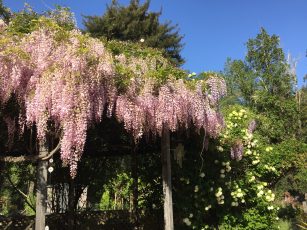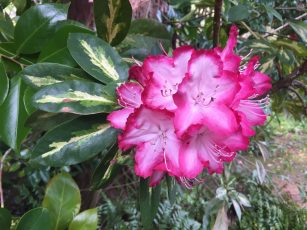Early summer is the right time for many garden activities that you don’t want to leave to chance. Keep these reminders in the back of your mind to tackle when the mood hits you.

Look for any pest problems so you can do something about them before they get out of hand. I?m OK with a few holes here and there but a heavy infestation should be trimmed off or sprayed with an organic insecticide.I inspect the tips of my fuchsias regularly for fuchsia mites and clip off any distorted growth. I hate to spray even organics on fuchsias due to the hummingbird activity. Lately I?ve seen rose slugs making lace out of the leaves so I crush by hand or spray with organic BT. Walk around your garden with a beverage in hand to spot problems on a regular basis.
Many plants, both vegetable and ornamental, are bothered by aphids and other sucking insects as well as foliage and flower eating bugs. From cucumber beetles, flea beetles, stink bugs, weevils, curculios to borers , the list of trouble makers is endless.
To help deter them mix up some pepper spray in your kitchen.
- 1 tablespoon hot pepper sauce or 1 teaspoon cayenne pepper
- 6 cloves garlic, crushed
- 1 quart warm tap water
Let stand I hour, strain and spray plants either in the morning or evening.
If you battle dandelions and don’t want to use chemical weed killers around pets and children, get out the white vinegar from the cupboard. On a hot sunny day spray straight white vinegar directly on the weed. This method will kill whatever it touches so direct the spray carefully. If the dandelion is in the lawn, wait a week, pour some water on the dead spot to dilute any lasting effects of the vinegar. Then poke some holes and drop in grass seed. Sprinkle a bit of fertilizer where the seed is planted and keep the area moist. In three weeks you won’t remember where the dead spot was and the dandelion will be long gone.
Another garden to-do this month includes summer pruning of wisteria. To increase flowering next spring and keep these vines under control cut new growth back to within 6″ of the main branch. If you want to extend the height or length of the vine, select some of the new streamer-like stems and tie them to a support in the direction you wish to train the plant.

While I have the pruners out I?ll be shearing back early flowering perennials to encourage another round of blooms. The season has just started and you’ll be enjoying lots more flowers in the months to come if you deadhead regularly. Perennials and shrubs that benefit from trimming an inch or two below the spent blooms are erysimum, lavender and Pink breath of heaven which will keep them compact.
Twist off spent rhododendron flower trusses and fertilize them.
Apply the second fertilizer application for the year to your citrus and fruit trees. The last one should be immediately after harvest. Apply the fertilizer to the soil around the drip line of the tree where feeder roots are located and scratch into the surface. Water in well. As with all fertilizers, make sure the trees are moist before you fertilize. Young trees in their first, second or third growing season should receive half the rate of established trees.
